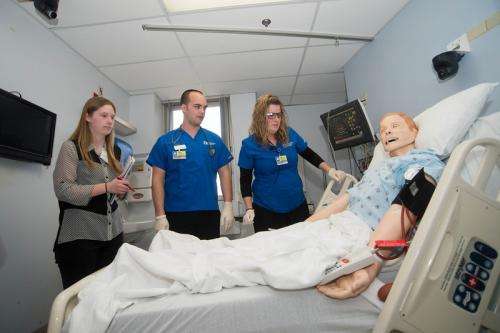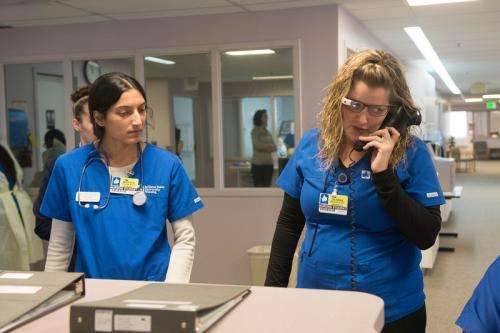Students help test new Google device

Deirdre Dugan's shift as a hospital charge nurse was eventful.
An Alzheimer's patient walked away from his room without being noticed, and an extensive search of the floor came up empty. A woman with severe abdominal pain from appendicitis balked at life-saving surgery without speaking with her absent husband. Yet another patient, healing well and about to be released, suddenly developed a blood clot and went into cardiac arrest.
From directing search efforts for the confused patient to discussing the risks of delaying emergency surgery and pitching in to help resuscitate a patient, Dugan handled each challenge with precision and poise.
Others will learn from her experience, because a tiny camera and computer attached to the eyeglasses she was wearing recorded her every movement.
The pulse-racing excitement was just fantasy and the hospital unit Dugan led was fictional. Dugan, of Sullivan, is a student in Indiana State University's accerated degree nursing program. The Alzheimer's and appendicitis patients were simply actors and the patient with a blood clot just one of several sophisticated mannequins used every day at the Rural Health Innovation Collaborative Simulation Center. Google Glass is one of several new teaching tools the center is using.
The Simulation Center offers a safe way for students and health care providers to fine tune their skills using real-life scenarios without using actual patients.
"We were running what is referred to as a high-fidelity multi-patient simulation event," said Robert Owegi, nursing instructor at Indiana State. "The students have to use some of the education experience they've gathered so far at ISU ... to get to the outcomes that they would like to see with their patients."

While cameras are already in place throughout the Simulation Center, they are mounted in the ceiling and thus provide a birds-eye view of activity.
Google Glass records the students "point-of-view" experience, Owegi noted.
Testing and evaluation of Google Glass has just begun but educators say the device offers promise for improving health care education.
"In spite of students having the education to develop their critical thinking and clinical judgment through limited clinical experiences, sometimes we want them to translate the theoretical concepts they've learned more quickly in a clinical environment, and what they're looking at tells us what they value more," Owegi said.
"If they're seeing their patient go down and they're fixated on the monitor and not looking at their patient, we as educators can jump in and say, 'You need to make that connection. It's OK to glance at the monitor, but that focus should be translated back, reverted back to your patient so that you can react appropriately,'" he said.
Dugan said she was initially nervous about having to complete the simulation exercises while wearing the camera-equipped glasses, but soon she barely noticed the camera's presence.
"I thought I was just going to see it the whole time but you actually don't even notice it when you're looking straight forward. You have to look up into the corner of the glasses and focus on it to see it," she said. "This is just someone wearing glasses and nobody really even thinks about it recording.
There are times I don't even realize what it's recording because I'm just looking around doing what I would normally do during the simulation."
Google Glass is not yet available to the public, but organizations interested in testing it can submit applications to Google explaining their goals for such tests, said Jack Jaeger, director of the Simulation Center.
Google approved Jaeger's application and permitted the Rural Health Innovation Collaborative to purchase one Google Glass as an "Explorer," which is Google's term for groups and organizations pledging to use the instrument in innovative and unusual ways.
"Healthcare simulation is an important and beneficial educational tool in teaching the next generation of providers how to care for complex patient situations," Jaeger said. "Google Glass puts us on the cutting edge of this training method. It allows us to see and learn from a student's visual point of view. And this allows our center to do things that very few places in the country are capable of doing. It's very exciting."
Students from Indiana State's applied medicine and rehabilitation and social work departments have joined nursing students in testing Google Glass at the Simulation Center, along with students from Indiana University School of Medicine-Terre Haute and Ivy Tech Community College.
Provided by Indiana State University



















